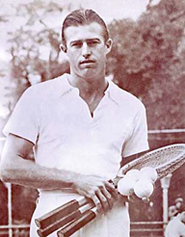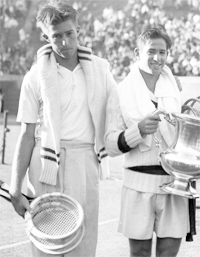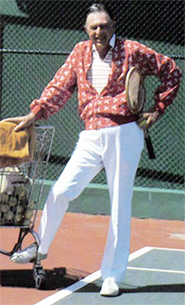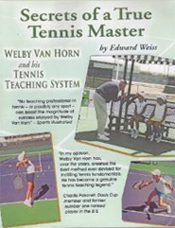Welby Van Horn:
In Memoriam
John Yandell

If you go to the Teaching Systems section of Tennisplayer (Click Here) you can find one of the most detailed, powerful, and influential approaches to tennis ever created, from Welby Van Horn, our friend, who passed this life in September at the age of 94.
Welby was the highest level player in the history of American tennis to become a systematic teacher. He reached the final of the U.S. Nationals losing to Bobby Riggs in 1939. He won the U.S. Professional Championship in 1945. No doubt he was one of the 10 best players of his era in both the amateur and the professional ranks.`
Welby began teaching in the 1940's while still playing professional tennis. In 1951 he moved to Puerto Rico hoping the climate would help his chronic asthma. Working with local kids who had never played tennis, he forged an almost unbelievable record of developing elite junior players. 7 won U.S. National junior championships. Over 20 were ranked in the top 50 in the U.S. Men's.
His best known student, Charlie Pasarell, won the NCAA singles and doubles, became number one in the country, went on to play high level professional tennis, and eventually started the desert tournament that became the BNP Masters.

Three other elite junior players Welby developed went on to become championship college coaches: Joe Brandi, Andy Brandi and Manny Diaz ( also a long time Tennisplayer subscriber!)
There were literally hundreds of other players at all levels who learned the fundamentals from Welby at the camps he ran up and down the east coast in the U.S. And dozens of other teaching pros who went on to become influential in their own right. I remember seeing the ads in the back of World Tennis Magazine.
I met Welby in about 2005, in Indian Wells where he had retired. He was working on a book with my friend Ed Weiss,himself a former college player and a founding Tennisplayer investor. Although in his mid 80's at this point, Welby was still working with a limited number of juniors.
I found him to be incredibly passionate and intense. He agreed to do a series of articles for Tennisplayer, simultaneous with his work with Ed. In getting to know Welby I was shocked to discover that he had been using the concept of stroke models with detailed checkpoints since the 1940's, something that had become the basis for my own teaching system.
Secrets of a True Tennis Master remains one of the most detailed and valuable teaching compendiums ever created and is still available on Amazon (Click Here.)

I was far from the only teaching pro impressed with the book and with Welby himself. Tennisplayer contributor Scott Murphy also spent time with Welby in the desert and had this to say:
"Welby's book is a goldmine of instructional information and I feel very privileged to have an autographed copy. Welby was quick to answer questions I had about my own work as a teaching pro and to this day, to the benefit of my students, I implement what he told me. I'm honored to have met him.and very saddened to hear of his passing."
Ed Weiss who painstakingly authored the definitive presentation of Welby's teaching system put it this way:
"Welby was a true original: a top world-class player who excelled in teaching absolute beginners. He figured out his teaching system totally on his own, based on the fundamental concept of balance.
"He was opinionated, a taskmaster, cared about his students and, perhaps above all else, a perfectionist who could see the slightest flaw in his student's stroke. It was an irreplaceable and invaluable experience being able to spend so much time working with a master craftsman."
Over a period of several years of our travels to the desert the Tennisplayer team got to know Welby well. He did a book signing. He attended some presentations I did as part of our subscriber clinics. We did some fine dining.
I also sat with him many times in his box at the BNP watching matches and discussing the evolution of modern technique. What impressed me the most was that Welby had studied modern players with an open mind and great acumen.

He was very acute in his technical descriptions of the changes in the swings, the contact heights, the increased rotations of the arms and bodies, the racket and string technology - everything. Unlike some teachers of his era he wasn't threatened in the slightest by this nor did he feel the need to defend his system developed the era of wood rackets.
He saw an organic connection between the fundamentals of classical tennis as he understood them and the development of modern technique by geniuses such as Roger Federer. Working with Ed, Tennisplayer provided dozens of still photos for the book that illustrated these connections and the continuity of Welby's fundamental principle of balance over the history of the sport.
One day I was stunned when he brought up the subject of my book Visual Tennis. He had gone to the trouble of finding it in a library, and had given it, let's just say, a detailed read.
I wouldn't say he was particularly tactful and explaining where he thought it was inaccurate and needed improvement. That was a painful conversation but one that opened my eyes on a few points that resonated and have stayed with me.
Tennis would be a lot better off if all coaches and teachers had those kind of frank exchanges. Several years ago Welby moved to Florida and I lost track of him. I was saddened to hear he was gone. But what a life and what a contribution. I know I am not the only one who will remember him with fondness and much appreciation.




